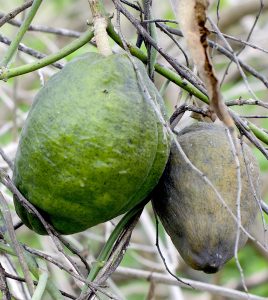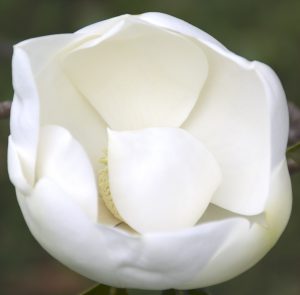
Blossoming Western Tansy Mustard. Photo by Green Deane
From a distance, or with older eyes, the Western Tansy Mustard can resemble Ragweed, or vice a versa. And locally they are in season about the same time. But the Western Tansy Mustard has much finer leaves, doesn’t grow as tall, is a lighter green, and of course has a mild mustard flavor. Ragweed has a strong flavor unless boiled twice. But I recommend you don’t eat that. We don’t know if there are long-term affects from eating Ragweed. The Western Tansy Mustard also likes dry weather and dry locations. You find it in unwatered lawns and fields. A very common place to locate the mild mustard is near paddocks and other dry places livestock are kept or visit. For a small plant that most folks don’t notice it actually has quite a history. You can read about it here.

Fruit of the Latex Strangler Vine. Photo by Green Deane
If you have been following the news Florida had some cold weather a couple of weeks ago. Two mornings in a row my bird bath was frozen. The electricity bill quadrupled. Such cold weather also allows one to study the moderating effects of bodies of water, small and large. I used to own a Carambola Tree, about 60 miles north of where they like to grow. But it was beside my pool, protected by the house and a fence. It fruited all year even after cold weather. This past weekend I had a foraging class in Largo, Fl., which is slightly northwest of Tampa. Ten days ago the overnight temperatures dipped into the upper 20s, enough to freeze a lot of species not accustomed to it. At the Eagle Lake Park in Largo we saw the unfrozen fruit of the Latex Strangler Vine. Despite its name it is a prime wild edible. And in this case in trees right on a small lake. It’s not unusual for the vine itself to survive our winters because the root is protected in the ground. But to see its fruit escape a local freeze because of heat from the lake was educational. You can read more about the Latex Strangler Vine here.

The mighty Heart Leaf Nettle. Photo by Green Deane
It is worth repeating the warning that this is stinging nettle season. While we have two different species of “stinging nettles” the one proliferating in lawns now is the Heart Leaf Nettle, in the genus Urtica. The other is in the genus Cnidoscolus. The Heart Leaf Nettle has perhaps has the second-worst Urtica sting on the planet. There’s one in New Zealand that is a killer. This one just hurts big and lasts long. Its botanical name means “Stinging Dwarf.” I would much rather take a few bee stings than a bite from the Heart Leaf Nettle. It treats me badly, creates a welt and hurts for many days. I can eat it, however, with no problem. Perhaps in contrast to its out-sized sting the species does not grow very tall: A foot high is a good-sized plant. As it is too warm most of the year for the species to thrive it shows around Christmas and is usually gone around March, give or take a few weeks depending on the weather. The main problem is that it grows in and among other edibles this time of year. Thus one can be reaching for a pleasant nibble only to be viciously mugged by this warrior of chemical warfare. You can read about this stinging nettle here.

Simpson Stopper Leaves Photo by Green Deane
Dimpled, round and pointed. The Simpson Stopper has three different kinds of leaves: Dimpled, round and pointed. They also have their own particular aroma when crushed (in that regard they all smell the same.) The species is a native and is being encouraged in landscaping. It also has twin berries that ripen to orange. Depending where you are in the state some are fruiting already or blossoming in other areas. The berries themselves resemble marmalade in flavor with a bit of bitter aftertaste. Like the leaves, the flavor is distinct. Another interesting aspect of the Stopper is that its seeds — which you don’t eat because they taste bad — taste like unripe Suriname Cherries which easily insult the mouth. And indeed the shrubs — Simpson Stopper and Surinam Cherry — are related and have been in and out of mutual genera for several decades. And to complicate things there are many species of Stoppers. You can read about the conumnrum here.

Foraging classes are held rain or shine, heat or cold.
Foraging Classes: This week we had our second class at a new location, Eagle Lake Park in Largo. It was flush with many common winter edibles and should be an interested location as spring approaches. This weekend we are in Sarasota.
Sunday, February 4th, Red Bug Slough Preserve, 5200 Beneva Road, Sarasota, FL, 34233. 9 a.m.
Sunday, February 11th, Jervey Gantt Recreation Complex, 2390 SE 36th Ave., Ocala, FL, 34471. 9 a.m. Meet at the entrance to the pool, aka Aquatic Fun Center.
Saturday, February 17th, Wickham Park: 2500 Parkway Drive, Melbourne, FL 32935-2335. 9 a.m. Meet at the “dog park” inside the park.
Sunday, February 18th, Blanchard Park, 10501 Jay Blanchard Trail, Orlando, FL 32817. 9 a.m. Meet at the Pavilion east of the tennis courts near the YMCA.
Sunday, March 4th, Eagle Park Lake, 1800 Keene Road, Largo, FL 33771. 9 a.m. Meet at the pavilion by the dog park.
For more information about the foraging classes go here.
 Donations to upgrade EatTheWeeds.com are going well (though I need to get a better handle on Go Fund Me’s mailing program.) Thank you to all who have contributed to either via the Go Fund Me link or by the PayPal donation link. It still has a ways to go. However, the fund has already started paying down the cost of the first phase of upgrades started in September. The site went down just before Hurricane Irma and was off line for about a month. When it came back with a new look many features were not functioning. Some are still buggy such as updating the ARCHIVE section. ETWs itself has been up for over a decade and the operating system was older than that. Many of the adds-ons and plug-ins were no longer working so it needed a major overhaul. The site’s content itself took many years to create. It contains information about over a thousand of edible plants. The site has 145 related videos which are currently on You Tube. Hopefully they can be moved back to the site. The Green Deane Forum has some 12,000 posts with plans to expand. The goal is to upgrade more, do more videos and get a book published. I also want to get the site in shape so I can will it to some organization that can own and maintain it when I’m long gone. You can go to the Go Fund Me page here, or, if you want to use PayPal instead you can use this link.
Donations to upgrade EatTheWeeds.com are going well (though I need to get a better handle on Go Fund Me’s mailing program.) Thank you to all who have contributed to either via the Go Fund Me link or by the PayPal donation link. It still has a ways to go. However, the fund has already started paying down the cost of the first phase of upgrades started in September. The site went down just before Hurricane Irma and was off line for about a month. When it came back with a new look many features were not functioning. Some are still buggy such as updating the ARCHIVE section. ETWs itself has been up for over a decade and the operating system was older than that. Many of the adds-ons and plug-ins were no longer working so it needed a major overhaul. The site’s content itself took many years to create. It contains information about over a thousand of edible plants. The site has 145 related videos which are currently on You Tube. Hopefully they can be moved back to the site. The Green Deane Forum has some 12,000 posts with plans to expand. The goal is to upgrade more, do more videos and get a book published. I also want to get the site in shape so I can will it to some organization that can own and maintain it when I’m long gone. You can go to the Go Fund Me page here, or, if you want to use PayPal instead you can use this link.

Keynote Speakers at the Florida Herbal Conference Linda and Luke Black Elk.
There are two conferences this month: Earthskills in Hawthorn, and the Florida Herbal Conference near Lake Wales. I lead plant walks at both events. Earthskills is next week, Feb 7-11 and the Florida Herbal Conference is Feb 23-25. Both are still accepting registration. You can register at Earthskills here. Keynote speakers this year at the Florida Herbal Conference are Linda and Luke Black Elk from the Standing Rock Reservation. Linda (of the Catawba Nation) is an ethnobotanist specializing in teaching about culturally important plants and their uses as food and medicine. She is a lecturer at Sitting Bull College in Fort Yates, North Dakota. Luke Black Elk (Thítȟuŋwaŋ Lakota) is a storyteller, grassroots activist, and traditional spiritualist. He has conducted research in water restoration, sustainable building design, and food sovereignty, and hopes to use these techniques to encourage a more traditional way of life among his people. Luke has lived on the Cheyenne River Sioux Reservation his entire life, becoming deeply involved in cultural and community activities. For more information about the Florida Herbal Conference go here.

Magnolia petals can be eaten. Photo buy Green Deane
It’s a natural assumption: Blossoms are usually delicate thus they can’t harm you. I know of a local blossom that even a tiny amount ingested will send you to the hospital with gastric distress, perhaps more. And the Mahoe blossoms while edible are tough. Hibiscus blossoms, admittedly, usually are pretty but flavorless. They add color and texture to salads. One blossom overlooked for culinary use is the Magnolia, big, showy and very fragrant. I am often asked if the seeds are edible and the answer is I do not know. I have never seen any reference to seeds. However the blossom does have its uses. The petals can be used as a spice. Usually I chop them and semi-pickle them in a sweet and sour solution, read vinegar and sugar. Flower buds can also be used as a spice. But, just as the scent of the blossom is strong so is the spice or relish. Use sparingly or your dish will be too magnoliaesque to consume. I have heard of people batter frying the petals but that strikes me as questionable, that is, strong-flavored. To read more about the magnolias go here.

Green Deane Forum
Want to identify a plant? Looking for a foraging reference? Do you have a UFO, an Unidentified Flowering Object you want identified? On the Green Deane Forum we chat about foraging all year. And it’s not just about warm-weather plants or just North American flora. Many nations around the world share common weeds so there’s a lot to talk about. There’s also more than weeds. The reference section has information for foraging around the world. There are also articles on food preservation, and forgotten skills from making bows to fermenting food. One special section is “From the Frightening Mail Bag” where we learn from people who eat first then ask questions later. You can join the forum by clicking on “forum” in the menu.

Make sure you remove all glochids. Photo by Green Deane
How to pick a cactus pad. In a word … carefully. Most foragers know cactus have edible parts but what does one look for, generally? First make sure it’s a pad, segmented often oval or tear-drop shaped. You do not want anything that looks serpentine. Also no white sap. White sap in plants that resemble cactus can be very deadly even after being dry for many years. In one case smoke from burning dessicated Euphobia branches killed some stranded people. They were trying to stay warm around the fire on a cold desert night. So, pads, no white sap. While which cactus you collect (Opuntia or Nopales) might be the luck of the draw, the less spines the better, and the less glochids the much better. Glochids are tiny tuffs of sharp hair that hurt, are hard to dig out, and last for days. Ma Natures knows the pads are good food so she protects them mightily. Big spines can be cut, burned or scraped off, glochids burned or washed off. Just scraping is not so successful with glochids. Wear stiff gloves without seams. Those little glochids will pass right through seams or cloth and get ya. Hint: Young pads, the ones we want anyway, often have not developed glochids. Let us presume you have a spineless, glochidless young pad. What do you do with it? You can eat it raw, skin and all, or roast it or boil it. I know one restuarant that steams them (preserving color) then lightly grills them puting the pads whole on a Mexicanesque hamburgers. With older (de-spined) pads you can still eat them raw or cook. Usually the tougher spine “eyes” are removed just like you would with a potato. And the pad can be peeled as well. Pads at a certain point become woody and too tough to eat. To read more about cactus click here.

Green Deane DVD set of 135 videos
All of Green Deane’s videos available for free on You Tube. They do have ads on them so every time you watch a Green Deane video I get a quarter of one cent. Four views, one cent. Not exactly a large money-maker but it helps pays for this newsletter. If you want to see the videos without ads and some in slightly better quality you can order the DVD set. It is nine DVDs with 15 videos on each for a total of 135 videos. Many people want their own copy of the videos or they have a slow service and its easier to order then to watch them on-line. The DVDs make a good gift for that forager you know especially on long, cold winter months. Individual DVDs can also be ordered or you can pick and choose. You can order them by clicking on the button on the top right hand side of this page (if your window is open wide enough.) Or you can go here.
This is weekly issue 289 and note there is one more article below.
If you would like to donate to Eat The Weeds please click here.
There are at least three wild edibles in this photograph..



I have found that a thick spit poultice of Bidens alba works extremely well to relieve the sting of the Heartleaf Nettle. For best results secure it with a bandage and leave on as long as possible, but we (my kids and I who love to walk barefoot) only need it a few hours at most.